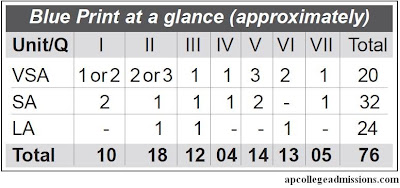Section - A:
It comprises 10 very short answer type questions. Each carries 2 marks. All questions must be answered. The answer may be upto 5 lines. Some time the answer may be in one or two words. Figures not necessary. Answers must be written in one place as per the sequence.
Section - B:
It consists 8 very short answer type questions. Each question carries 4 marks. The student has to write answers for 6 questions only. The answer can be written in 20 lines. Figures should be drawn, if necessary.
Section - C
It consists 3 long answer type questions. Each question carries 8 marks. Student has to write answers for 2 questions only. Answer should be limited to 60 lines. Figures must be drawn in case necessity arises. Blue Print is given by the Board of Intermediate Education. It deals with weightage of each unit. The details are as follows.
- Unit I (10 Marks), Unit II (18 Marks), Unit III (12 Marks), Unit IV (4 Marks), Unit V (14 Marks), Unit VI (13 Marks) and Unit VII (05 marks). The examiner may not follow this in letter and spirit. It may be altered.
- Every unit is further divided into chapters. At the end of each chapter Very Short Answer (VSA), Short Answer (SA), Long Answer (LA) type questions and Exercises are given.
- Questions (VSA or SA) may also be asked from Exercises too. Now let us plan to study.
Unit I: Diversity in the Living World
It has 4 chapters. It deals with general characters of living organisms, their distribution, classification and branches of Botany. It is a difficult chapter. It needs understanding of the subject at large. Answers must be prepared with teachers help for all types of questions. It is difficult to retain. Chapter 2 and 4 must be read several times. Examples are more. They should be listed separately and read several times. 2 or 3 VSA and 1 or 2 SA may be asked from this Unit. In March 2013, 3 VSA and 2 SA were asked.
Unit - II: Structural Organisation in Plants
It deals with external morphology from Root to Fruit. The student gets his fundamentals or basics in it. It is full of figures and examples. Practical knowledge is essential. Student can see all in nature. The knowledge, depth in this unit is highly required for further understanding of Botany. Not only in theory but also it helps in practical exams. This Unit, as per blue print carries 18 marks. One or 2 VSA, 2 SA and one LA type questions may be asked from it. One VSA, One SA and One LA type questions were asked in March 2013. Suitable figures with sufficient labelling must be prepared in advance. There are 3 LA type questions in the text book. So, student gets one out of these 3
questions.
Unit - III: Reproduction in Plants
It has 2 chapters. It carries 12 Marks. One VSA, SA and One LA type questions were asked in March 2013. It deals with reproduction in plants. Again it is very important after Unit II. Basing on the theory, problems may be set in VSA.
Unit - IV: Plant Systematics
Its study requires the knowledge of Unit II. It carries 4 marks only. But one VSA and One SA (Total 6 Marks) were asked in March 2013. We have 3 families only. LA type questions are not possible from it. The student must be well acquainted with floral formula and floral diagram. Scientific & common names of the plants belonging to 3 families should be taken care of.
Unit - V: Cell Structure and Functions
It has 3 chapters. It carries 14 Marks. Fundamentals learned in this unit will be useful further in Genetics, Physiology and Biotechnology. So after morphology it is another basic unit. It is actually a difficult chapter. Questions are too many. So answers should be prepared very precisely. It needs more chemistry knowledge. VSA and SA in chapter 11 are very difficult for the student to prepare answers. He/ She must take the experienced teachers help.
One VSA and 2 SA are asked in March 2013.
Unit - VI: Internal Organisation of Plants
It has only one chapter. It carries 13 Marks. One SA and one LA are asked in this March. It is figures oriented chapter.
Unit - VII: Ecology
It is the easiest unit. It carries 5 marks. One VSA and one SA are asked in March 2013. Its study depends upon the unit II knowledge.

No comments:
Post a Comment